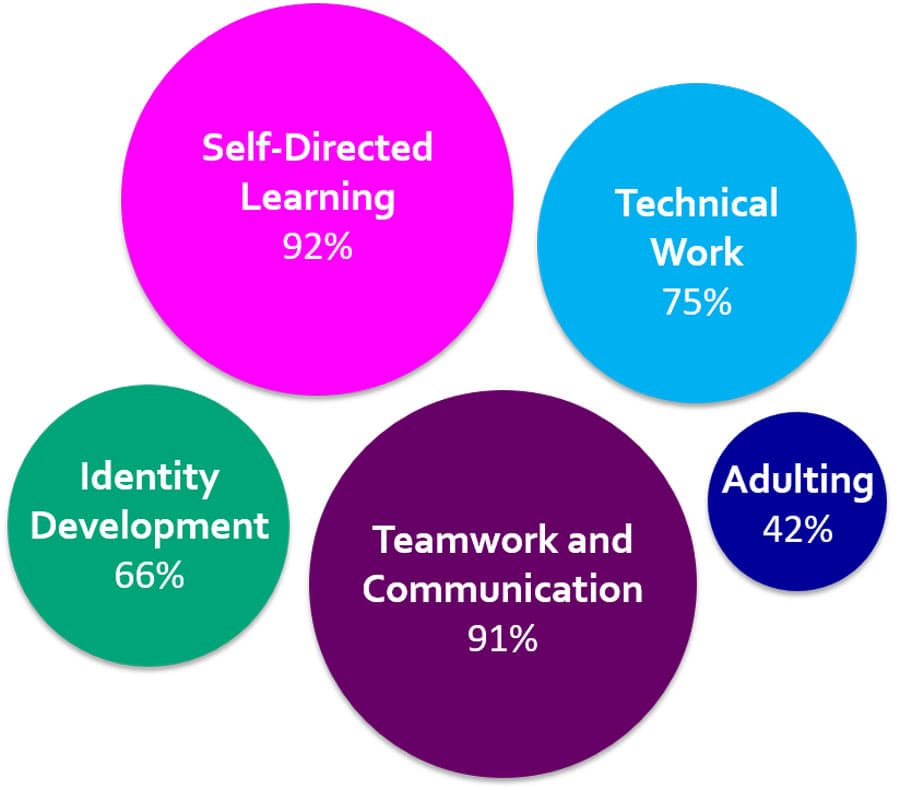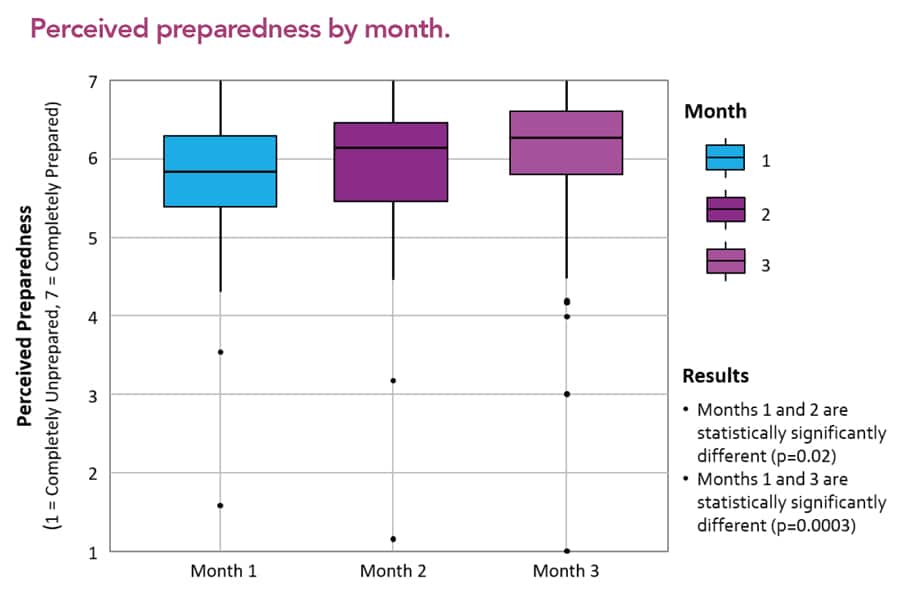Engineering capstone courses help students transition from school to work
Many engineering students in the USA and other countries undergo capstone design courses at the end of their undergraduate experience. Similar to clinical experience for medics and lawyers or bachelors’ theses in some European countries, capstone courses offer academic experiences aiming to bridge school and work. These courses are a place where students bring together knowledge from previous courses plus new learning in application to industrial projects for external clients, while simultaneously expanding students’ professional skills.
Since their inception in the 1980s, capstone design courses have become ubiquitous because of their potential to enhance students’ professional preparation in engineering. They often take the form of a semester or year-long team project sponsored by external clients from industry and government. Despite a growing body of research into capstone courses – investigating the types of teaching, testing, and course structure – few studies have tracked students’ journeys from capstone design into professional workplaces.
Capstone to Work Research
The “Capstone to Work” (“C2W” for short) project is studying this transition, focusing on what activities new employees engage in, how prepared they feel for various tasks, what challenges they face at work, what strategies they employ to meet these challenges, and, in particular, what aspects of capstone design transfer to their early careers. The research has major implications for improving both capstone courses and industry on-boarding practices to smooth the transition and ensure prepared and proficient new employees.

Led by Marie Paretti at Virginia Tech, alongside Julie Ford (New Mexico Tech), Susannah Howe (Smith College) and Daria Kotys-Schwartz (University of Colorado Boulder), the C2W team recruited 120 graduates from two different years at four institutions as they completed project-based capstone design courses. The capstone courses at these institutions were consistent with national trends in terms of course structure and teaching. Every participant was interviewed at the end of the capstone design course, and also after 3, 6 and 12 months of being in the workplace. During their first 12 weeks of work, the graduates also recorded their workplace experiences in twice-weekly surveys and reflective journals.
New Engineers’ Experiences
Analysis of the extensive interview and survey responses provides a rich window into participants’ experiences shifting from the role of student to that of new engineer.
Tasks and Activities
In their first three months, the new engineers were involved with many different tasks and activities, the most frequent of which included team meetings, project planning, design generation/refinement, technical calculations, CAD modelling, and report writing. They also spent significant time learning new information associated with their organisation and industry. These activities are common in capstone design courses, suggesting that these courses are successfully mirroring workplace environments. Formal training also occurred for some new engineers during their first month on the job.
New employees are expected to be self-directed learners, able to quickly grasp technical concepts as well as a company’s culture and goals.
Perceived Preparedness
In general, the new engineers felt well-prepared for the tasks and activities they encountered. Participants from all four institutions reported feeling more prepared on average for work the longer they were on the job. Notably, many participants also reported receiving feedback on their performance from supervisors and colleagues, so while these perceptions are self-reported, they are also contextualised. Women reported the same average growth in perceived preparedness as men, but reported statistically significantly lower absolute values in months 2 and 3 when asked to rate themselves on a numeric scale (1-10). That is, women’s sense of preparedness increased at the same rate as men, but they scored themselves lower numerically. These findings are consistent with prior research showing that women typically underrate their performance on tasks while men overrate their performance.

Challenges
While participants reported feeling prepared for workplace tasks and activities, their first twelve months of work were not free from challenges. More than 90% of the new engineers experienced challenges related to self-directed learning (particularly lack of knowledge and time management) and teamwork and communication. Almost all participants reported needing to get up to speed quickly on new technical content, products, and processes, and many were challenged to figure out for themselves how to complete their work by marshalling resources or people rather than receiving direct instruction. Some participants also struggled to manage their own time and energy effectively, both when juggling multiple projects and when work was scarce, noting that the pacing of work was very different from residential college life. Multiple participants noted a mismatch between their capstone team experiences (mostly peers, mostly similar technical experience, little authority) compared with work teams (more diversity in experience and discipline, clearer hierarchy), though many were able to transfer their teamwork skills to this new context. Those who considered themselves less prepared for working in teams were also less successful in transferring their teamwork skills across contexts.
Strategies
Participants used multiple strategies to meet these challenges, the most common of which were talking to people and drawing on capstone design experience. A recurring theme amongst participants was the critical role of interpersonal relationships at work. Asking coworkers and supervisors questions proved an essential strategy in developing knowledge, building confidence, and gaining a sense of belonging, but also required significant navigation in choosing when and who to ask for help.
Transfer from Capstone
Capstone design was a dominant source of skills and strategies for participants. In particular, 85% of participants leveraged their capstone design experiences related to self-directed learning, and 74% drew on teamwork and communication skills. These results are heartening, given that self-directed learning, teamwork, and communication are key components of capstone courses. Many of the new engineers also commented that capstone design served as a mini-version of the workplace, and that the experiences they had at work were just more complex or larger versions of capstone design, which significantly eased their transition.
85% of participants leveraged their capstone design experiences related to self-directed learning, and 74% drew on teamwork and communication skills.
Implications for Capstone Educators and Employers
There is no single representative pathway for engineering graduates; participants’ experiences highlight the sheer diversity of engineering work – design, troubleshooting, problem-solving, reviewing, field work, and more. New engineers describe engineering in different terms and their experiences resist binaries present in master narratives of engineering work: social versus technical, innovation versus maintenance, holistic versus narrow.

Because engineering work is so diverse, new employees are expected to be self-directed learners, able to quickly grasp technical concepts as well as a company’s culture and goals. Capstone design courses serve as critical preparation, providing students with confidence to learn new things and strategies for building new knowledge. The courses provide authentic industry experiences through open-ended projects that place students out of their comfort zone. Through capstone design, students assimilate the knowledge they have gained in education, and use skills in a setting that requires professional attitudes and behaviours. Faculty teaching capstone design can help prepare students for this self-directed learning through guided mentorship and modelling effective learning behaviours.
Additionally, new employees depend on technical skills, but depend even more on communication skills. Capstone design courses are a natural setting to gain these skills, given their focus on teamwork and communication. Students equipped with effective communication are better prepared to learn new skills from their colleagues and managers.
While capstone courses can help prepare new graduates for their first weeks and months working in industry, there are limits to the role these courses can play. For example, they will always struggle to replicate the range of experiences and ages present in professional settings. Similarly, while capstone projects can simulate some workplace challenges in terms of time pressures and competing demands, they cannot fully replicate the financial and business consequences found in industry or the time constraints of a workplace in which professional colleagues work during business hours and head home to families and personal lives after work. Finally, capstone design courses – and even contemporary residential universities – cannot prepare students for the broader challenges of emerging adulthood as they seek to separate and balance their developing personal lives with their professional commitments.

In short, regardless of their training in school, new graduates enter workplaces with steep learning curves where they perform activities and face situations they did not experience in school. Organisations hiring engineering graduates must share a role in facilitating successful school-to-work transitions by enculturating new employees and providing them with the training and resources necessary to help them activate and adapt their educational preparation, including capstone design. As such, academic preparation and industry onboarding act as partners to position new engineers for successful and rewarding careers.
Personal Response
What impact does this work have on you as capstone design educators, researchers, and students?
<> This work reinforces for me, a capstone educator, the value of open-ended, applied design experiences in preparing students for their careers. The struggles and successes my students have during capstone design will pay off as they enter the workplace.
As a student, working on the C2W project has made me feel more prepared for life after college: what to expect and how to handle the transition.
The research findings help me to be intentional with each student interaction in capstone. Additionally, we are able to inform our corporate partners what to expect as our alumni enter the workforce.